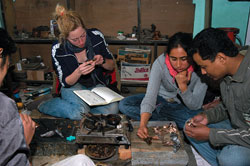|
|
Erna Anema came to Nepal from the Netherlands for the mountains, but she fell in love with Kathmandu's art.
Anema was fascinated with the silver and copper work and the delicate intricacies of jewellery-making in Kathmandu. She came back, again and again, and worked with the Nepali artisans. She began wondering if there was potential for an exchange between Dutch and Nepali students.
"The Nepali method is essentially different from the Dutch: in Nepal, artisans think in terms of traditions and techniques, often reproducing early styles and ignoring their own originality, whereas Dutch students learns to think in concepts," she explains.
Anema tried to organise an exchange program 10 years ago, but realised that although the students were curious and enthusiastic, their teachers were not very eager to experiment. Last year, along with another teacher, Sophie Krier, she proposed a collaboration between students of Gerrit Rietveld Acadamy in Amsterdam and the Kathmandu University Centre for Arts and Design, and was pleasantly surprised by the enthusiasm of the teachers.
"A lot has happened in Nepal in the last ten years, those in the Nepali art scene now are more open to thinking outside the box," says Anema.
The collaboration got off the ground with support from the Dutch embassy in New Delhi. Some 20 Dutch students wrote proposals about what they wanted to do with their Nepali partners for four-week collaborations, designed creative invitations which reflected their personal interests and the art they wanted to make, and sent them to Nepal.
During their first week here, the students trekked together for a few days, attended workshops and lectures, and then began to work together. Six Dutch and three Nepali teachers are supporting the project in Nepal. Their projects range from jewellery, bronze and copper casting and ceramics, to wood carving, basket-making, and even electric wire weaving.
The students start from a word or a context, then try to find a personal focus, which can be observed and questioned. The projects can't be completed solo and the students are encouraged to question their every decision.
Now in their last week of collaborative work, the students are busy finishing off for exhibition on 14 March at the Nepal Art Council, Babar Mahal. In September, five Nepali students from the group will go to the Netherlands for the other leg of the exchange.
(Mallika Aryal)
In Between
Nepal Art Council, Baber Mahal
14-15 March, 10:00-17:00
www.design.nl



